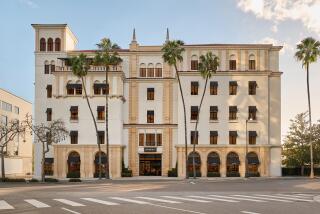$550-Million Deal to Help May Stores Fend Off Takeovers
May Department Stores, which so far has escaped the wave of takeovers in the retailing industry, on Wednesday tentatively agreed to a $550-million deal that could tighten its defenses against a corporate raider and help it expand its shopping center network.
The St. Louis-based retailer said its shopping center division would enter a 50-50 partnership with PruSimon, a venture being formed by Prudential Insurance Co. and Melvin Simon & Associates.
Under the deal, PruSimon would contribute $550 million in cash to May Centers Associates, which will operate May’s 28 shopping centers nationally, including 12 in Southern California.
In a joint statement, the partners said they expect to enter a formal agreement within 30 days.
David C. Farrell, May Department Stores’ chairman and chief executive, said the venture will unite Prudential’s investment ability and Melvin Simon’s shopping center development skills with its own “strong organization and excellent shopping centers.” He said it also will free the retail company to concentrate on running its department stores, which include May Co., J. W. Robinson’s, Lord & Taylor, Foley’s and Filene’s.
Prudential Chairman and Chief Executive Robert C. Winters portrayed the deal as a “unique” investment opportunity, while Herbert Simon, president of Melvin Simon & Associates, called it a chance “to materially enhance the growth of May Centers.”
The agreement gives May the option of having May Centers Associates invest up to $550 million, PruSimon’s contribution, in May Department Stores’ stock. That could give May Department Stores a valuable ally in the form of a 10% shareholder in the event of a hostile takeover offer in an industry that has been hit by a rash of mergers--most recently, last April’s $6.6-billion acquisition of Federated Department Stores by Campeau Corp., a Canadian developer.
Some industry observers have speculated that Campeau, which sold Foley’s and Filene’s to May Department Stores earlier this year, might be tempted by May’s real estate holdings.
But the option also transforms May’s real estate assets into capital, pointed out Ron Rotter, an analyst with Morgan, Olmstead, Kennedy & Gardner, a Los Angeles brokerage firm.
“In a sense, it’s just a redeployment of assets,” Rotter said. “I don’t think it’s going to radically change May’s operation, but it certainly does give them a lot of capital.”
On the other hand, said Thomas H. Tashjian of Seidler Amdec Securities, the deal moves much of May’s real estate assets “into a more distant entity so as to make it less susceptible to being lost in a hostile takeover bid. And the (partnership) will have the option to own $550 million of May Co., which also protects it.”
May Centers’ option to invest as much as $550 million in the parent company would represent a 10% stake based on a $35 a share price, close to its current trading level. Tashjian said such a move would take some stock off the market and improve the parent company’s per-share earnings.
In terms of future operations, he went on, the partnership does give May “additional savvy and the financial wherewithal to go ahead and expand,” while giving Prudential an investment opportunity and Simon access to well located shopping centers.
“It’s a win-win situation for everybody,” Tashjian concluded.
More to Read
Inside the business of entertainment
The Wide Shot brings you news, analysis and insights on everything from streaming wars to production — and what it all means for the future.
You may occasionally receive promotional content from the Los Angeles Times.










